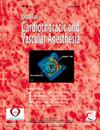VENO-ARTERIAL EXTRACORPOREAL MEMBRANE OXYGENATION SUPPORT AS A BRIDGE TO HEART-LUNG TRANSPLANTATION IN A PATIENT AFFECTED BY EINSENMENGER'S SYNDROME COMPLICATED BY PNEUMONIA AND SEVERE RIGHT VENTRICULAR FAILURE
IF 2.3
4区 医学
Q2 ANESTHESIOLOGY
Journal of cardiothoracic and vascular anesthesia
Pub Date : 2024-10-25
DOI:10.1053/j.jvca.2024.09.078
引用次数: 0
Abstract
Objective
We report a case of a 58-year-old male suffering from primary pulmonary arterial hypertension (PH), Eisenmenger's syndrome (ES) and ischemic heart disease who has already undergone multiple revascularizations and is a candidate for en bloc heart-lung transplantation.
Design and method
The patient acceded to our center with pneumonia and consequent worsening of respiratory symptoms and asthenia. The echocardiogram demonstrated a severely dilated and hypokinetic right ventricle with a systolic-diastolic D-shape and massive tricuspid regurgitation besides a dilated and fixed inferior vena cava. Considering the clinical worsening with advanced cardiorespiratory failure and the lability of hemodynamic compensation, hospitalization in cardiac intensive care was proposed. Upon admission, the patient presented a picture of predominantly right-sided SCAI D cardiogenic shock in type I PH and severe hypoxia.
Initially, the hemodynamic instability was successfully medically managed with epinephrine intravenous (IV) infusion, a combination of multiple pulmonary vasodilators (Milrinone EV, Epoprostenol EV, Treprostinil continuous SC infusion and iNO) and Non-Invasive Ventilation (NIV). The patient was then included in the emergency transplantation list.
Unfortunately, pneumonia severely worsened the pulmonary oxygenation with subsequent right ventricle de-compensation, increasing the right-to-left shunt and precipitating the cardiorespiratory equilibrium.
We discussed the possibility of supporting the patient with veno-venous (VV) ECMO, but the RV failure was too severe (TAPSE 11 mm, FAC 20%, PAPs 92 mmHg, CVP 18 mmHg) and unresponsive to maximal medical therapy to allow the venous-venous support adequate effectiveness. Therefore, we decided to assist the patient with an awake femoral-femoral veno-arterial (VA) ECMO bridge-to-transplantation.
As expected, it was not a simple mechanical circulatory support (MCS) management: the good LV function and the severe RV dilation made it impossible to obtain full drainage of the heart, which continued to eject de-oxygenated blood in ascending aorta. Veno-arterial-venous (VAV) ECMO was considered, but the incomplete RV drainage made it impossible to avoid liver stasis and a VAV configuration was considered inapplicable to manage the Harlequin Syndrome which occurred. Therefore, to improve the oxygenation in the “upper circulation” and, at the same time, to maintain the patient awake and able to prosecute physiotherapy, we assisted the patient with High-Flow Nasal Cannula (HFNC 50 L/min FiO2 100%) connected to an inhaled Nitric Oxide circuit (iNO 20ppm).
In this way, we managed to assist the patient for 10 days, up to organs arrival, and the the patient was successfully transplanted.
Results and conclusions
This case highlights the complexity and still the feasibility of VA ECMO support, complicated by Harlequin Syndrome, as a bridge to heart-lung transplantation in acutely decompensated patients with ES, in which the conditions of the right heart could not tolerate the VV ECMO solution.
静脉-动脉体外膜氧合支持作为一名因肺炎和严重右心室功能衰竭并发症的英森曼格综合征患者进行心肺移植的桥梁
目的我们报告了一例 58 岁男性患者的病例,他患有原发性肺动脉高压(PH)、艾森曼格综合征(ES)和缺血性心脏病,已经接受了多次血管重建手术,是心肺整体移植的候选者。超声心动图显示患者右心室严重扩张,运动减弱,呈收缩-舒张D形,三尖瓣大量反流,下腔静脉扩张且固定。考虑到临床病情恶化,心肺功能衰竭晚期,血流动力学补偿不稳定,建议患者住院接受心脏重症监护。入院时,患者主要表现为右侧SCAI D型心源性休克(I型PH)和严重缺氧。最初,通过静脉注射肾上腺素、联合使用多种肺血管扩张剂(米力农EV、表前列醇EV、曲普瑞斯替尼持续静脉注射和iNO)和无创通气(NIV),成功地控制了血流动力学的不稳定。不幸的是,肺炎导致肺氧合严重恶化,继而导致右心室失代偿,增加了右向左分流,影响了心肺平衡。我们讨论了用静脉-静脉(VV)ECMO 支持患者的可能性,但患者的 RV 功能衰竭过于严重(TAPSE 11 mm,FAC 20%,PAP 92 mmHg,CVP 18 mmHg),对最大限度的药物治疗反应迟钝,静脉-静脉支持无法充分发挥作用。因此,我们决定用清醒的股静脉-股静脉-动脉(VA)ECMO 桥接移植术为患者提供帮助。不出所料,这不是一种简单的机械循环支持(MCS)管理:良好的左心室功能和严重的左心室扩张使得心脏无法得到充分引流,而心脏继续向升主动脉喷射脱氧血液。曾考虑过静脉-动脉-静脉(VAV)ECMO,但由于 RV 引流不完全,无法避免肝脏淤血,VAV 配置被认为不适用于处理出现的哈勒金综合征。因此,为了改善 "上循环 "的氧合情况,同时保持患者清醒并能够进行理疗,我们使用了连接吸入一氧化氮回路(iNO 20ppm)的高流量鼻导管(HFNC 50 L/min FiO2 100% )对患者进行辅助。结果和结论:本病例突出显示了 VA ECMO 支持的复杂性和可行性,在右心条件不能耐受 VV ECMO 方案的 ES 急性失代偿患者中,VA ECMO 支持可作为心肺移植的桥梁。
本文章由计算机程序翻译,如有差异,请以英文原文为准。
求助全文
约1分钟内获得全文
求助全文
来源期刊
CiteScore
4.80
自引率
17.90%
发文量
606
审稿时长
37 days
期刊介绍:
The Journal of Cardiothoracic and Vascular Anesthesia is primarily aimed at anesthesiologists who deal with patients undergoing cardiac, thoracic or vascular surgical procedures. JCVA features a multidisciplinary approach, with contributions from cardiac, vascular and thoracic surgeons, cardiologists, and other related specialists. Emphasis is placed on rapid publication of clinically relevant material.

 求助内容:
求助内容: 应助结果提醒方式:
应助结果提醒方式:


